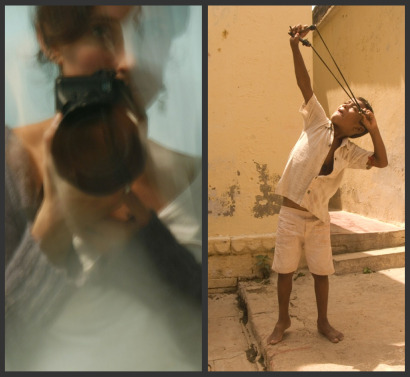By Haley Cullingham
This weekend, Toronto photographer Anthea Baxter-Page will present India: Life and Lens, at Alison Milne Design Studio. A collection of striking images from the photographers travels in India, Baxter-Page’s photographs paint a portrait of life, saturated with feeling and colour, in a country that surges with energy and mystery. We spoke with Baxter-Page about her travels, inspiration, and how vogueing in an internet cafe can lead to unexpected beauty.
SDTC: I was very inspired and intrigued by your comment that, with a language barrier, a camera can act as a liaison between people. Can you expand on this?
The visibility the camera gave me was huge. People were intrigued, and would approach me. And the task of shooting gave me the opportunity to interject myself into situations that, as a foreign traveler, I was outside of. We may not have spoken the same language, or shared the same experience but, for that moment, my subject(s) and I were communicating. I met a lot of great people that way.
What is it about India that most inspires you?
I find it really incredible that a billion people can live in such close proximity to each other, in such a cohesive, fluid existence. All of the Indians I met were warm, generous, jovial people who were content with their lives, despite sometimes having very little. We privileged North Americans could learn a thing or two from them.
What was the most challenging obstacle you encountered on your journey?
It’s hard not to get caught up in the poverty. Sure, there were a lot of instances that hurt the heart, but there is a lot of beauty as well.
Who are some photographers whose work you admire?
I get excited about a lot of Henri Cartier-Bresson’s work. I also love Robert Frank, Andre Kertesz, and Diane Arbus. And, of course, George Whiteside. I assisted him for years and he taught me a lot.
Much of your work focuses on images of children-what is it about the young people of India caught your attention?
Kids are more inquisitive and less skeptical than adults. They engage without reservation. And the kids in India specifically love the technology of the digital camera, and really want their picture taken. On many occasions, if I had my camera out, the kids would flock to me in hoards, smiling and jumping around and performing for the camera.
What is the process that determines for you whether to present an image in black and white or colour?
There’s a certain nostalgia to B&W photography. I love traditional documentary street photography so I threw most of my portraits into B&W to emulate that. One of the things I like about this collection is its timelessness: there are elements of Indian life that feel really ancient, like they’ve never changed. So to look at the B&W’s, it feels like they could have been taken 50 years ago.
What first led you to travel in India?
There’s a certain allure to that country that just can’t be explained. I wanted to go for years. I just knew that it was culturally so rich, it would be great material for shooting. So I packed up my gear and left, and I swear, I almost didn’t come home! It was such a strengthening, soul-searching journey and so important that I did it on my own.
Have you ever had a particularly interesting encounter with a subject?
There was one young man who really wanted his picture taken so I humored him. We had a little photo session in his internet cafe for about 15 minutes, and he was really ‘giving it’, posing this way and that. It was amusing. He was very concerned about his appearance, and was acting all suave. It was hard to get anything else out of him. But I finally caught him off guard while combing his hair in the mirror, and it’s now one of my favourite shots.
What led you to photography?
My step-mother is a photographer. She gave me a manual camera in university and I had to take a course to figure out how to use it. From there, I was hooked!
Any more photography adventures planned?
This show is part of a larger body of work, entitled Life and Lens, which started in Mexico in 2005, and I plan to continue the series in South America and Africa in the coming years.
Alison Milne Design Studio
49 Ossington Avenue, 2nd Floor
Opening Reception
Thursday April 22, 7 p.m. – 10 p.m.
Exhibition Continues
April 22 – May 23
By appointment Monday to Friday
Drop In Saturday and Sunday 12 p.m.- 6 p.m.



 Follow Us On Instagram
Follow Us On Instagram
